BEIJING, March 15 -- Following is the full text of the Report on the Implementation of the 2013 Plan for National Economic and Social Development and on the 2014 Draft Plan for National Economic and Social Development, which was submitted on March 5, 2014 for review at the Second Session of the 12th National People's Congress and was adopted on March 13.
REPORT ON THE IMPLEMENTATION OF THE 2013 PLAN FOR NATIONAL ECONOMIC AND SOCIAL DEVELOPMENT AND ON THE 2014 DRAFT PLAN FOR NATIONAL ECONOMIC AND SOCIAL DEVELOPMENT
Second Session of the Twelfth National People's Congress
March 5, 2014
National Development and Reform Commission
Fellow Deputies,
The National Development and Reform Commission has been entrusted by the State Council to submit this report on the implementation of the 2013 plan and on the 2014 draft plan for national economic and social development to the Second Session of the Twelfth National People's Congress (NPC) for your deliberation and for comments from the members of the National Committee of the Chinese People's Political Consultative Conference (CPPCC).
I. Implementation of the 2013 Plan for National Economic and Social Development
In the face of the complex domestic and international situations in 2013, all regions and government departments adhered to the general work guideline of making progress while maintaining stability; to the policy of maintaining stable growth, making structural adjustments and advancing reform; and to the requirement that our macro policies be stable, micro policies be flexible and social policies meet people's basic needs in accordance with the policies and plans of the Central Committee of the Communist Party of China (CPC) and the State Council. They did all their work well on the basis of the Plan for National Economic and Social Development approved at the First Session of the Twelfth NPC. As a result, economic and social development got off to a good start and overall implementation of the plan was good.
1. The economy performed within a proper range.
We did not waver on our policy. We created new ideas and methods of control. As a result, economic and social development progressed and improved steadily.
First, the economy as a whole was stable. Preliminary assessments indicate that China's GDP reached 56.88 trillion yuan, an increase of 7.7% over the previous year and in full accord with the targeted figure. China's government revenue increased by 10.1% to 12.91 trillion yuan and the deficit was 1.2 trillion yuan. RMB loans for the year increased by 8.89 trillion yuan. At year' s end, the broad money supply (M2) rose 13.6%. Profits of industrial enterprises with annual revenue of 20 million yuan or more from their main business operations reached 6.28 trillion yuan, an increase of 12.2% over the previous year. Demand for coal, electricity, petroleum, gas, and transport was satisfactorily met in critical areas and at important times.
Second, domestic demand continued to be the main driving force of growth. Retail sales of consumer goods totaled 23.78 trillion yuan, an increase of 13.1%. A number of new forms and areas of consumption were very vigorous, and the value of e-commerce transactions exceeded ten trillion yuan, an increase of more than 25%. China's total investment in fixed assets amounted to 44.71 trillion yuan, an increase of 19.3%. Private investment increased by 23.1% and accounted for 63% of the investment in fixed assets (excluding investment by rural households), 1.8 percentage points higher than the previous year. The contribution of domestic demand to economic growth reached 104.4%.
Third, overall price levels were basically stable. Consumer prices for the year rose 2.6%, within the targeted range. The work of purchasing, storing and releasing important commodities and of adjusting their imports and exports proceeded in good order. Trials of a policy-based insurance system for the market prices of hogs and vegetables were energetically carried out. We intensified inspection of prices and fees and law enforcement against monopolistic pricing, and handled 34,400 cases of pricing violations for the year and assessed fines totaling 3.125 billion yuan.
2. Progress was made in structural adjustment.
We stressed priorities, supported some areas while restricting others, and strove to raise the quality and returns of development and promote industrial upgrading in order to enhance the sustainability of economic development.
First, industrial structural adjustment proceeded steadily. Significant achievements were made in technological innovations and fostering emerging industries. R&D expenses accounted for 2.09% of GDP, hitting the targeted figure. The lunar lander Chang-e 3, the Shenzhou-10 manned spacecraft, the deep-sea manned submersible Jiaolong and other major innovative achievements captured the world's attention. Strategic emerging industries developed quickly, such as energy conservation and environmental protection, next-generation information technology, new energy, high-end equipment manufacturing, and new materials; and we began to put the 4G mobile communications system to commercial operation on a large scale. Value added of high-tech manufacturing industries grew by 11.8%, 2.1 percentage points higher than in industrial enterprises with annual revenue of 20 million yuan or more from their main business operations. We moved faster to transform and update traditional industries and worked harder to solve the problem of excess production capacity. We issued a notice to keep industries with a serious problem of overcapacity from expanding blindly. We issued guidelines and accompanying policies and measures for solving the serious problem of excess production capacity, and put great effort into resolving the problem of overcapacity in the steel, cement, electrolytic aluminum, plate glass and shipbuilding industries. We optimized the environment for developing the service sector. We issued policies and guidelines to spur the development of information consumption, elderly services and health services, issued a plan for developing a nationwide network of logistics parks, and continued to carry out comprehensive trial reforms in the service sector. Value added of the service sector increased by 8.3%, and it accounted for 46.1% of GDP, surpassing secondary industry for the first time. Basic industry developed quickly. There were 5,586 kilometers of new railway lines put into operation, of which 1,672 kilometers were high-speed lines. There were 70,300 kilometers of new highways put into service, of which 8,260 kilometers were expressways. We also put into service 110 berths for 10,000-ton class or larger ships and added ten new civilian airports. Power generation was stable, and the output of raw coal, crude oil and natural gas rose by 0.8%, 1.8% and 9.4%, respectively. The mix of energy sources was further improved, and energy generated from non-fossil fuels accounted for 9.8% of primary energy consumption, an increase of 0.4 percentage points over the previous year.
Second, the integration of urban and rural development proceeded in an orderly fashion. We conscientiously implemented the policy of boosting agriculture, benefiting farmers and increasing rural prosperity, and more than half of the central government budget allocated for investment was spent on agriculture, rural areas and farmers. Overall agricultural production capacity increased, and total grain production reached 602 million metric tons, the tenth consecutive year of growth. The supply of meat, eggs, milk, fruits, vegetables and fish was stable. Advances in agricultural science and technology contributed 55.2% to agricultural development, a rise of 0.7 percentage points over the previous year. The percentage of the rural population with access to safe drinking water reached 88.5%; 211,000 kilometers of rural power lines and 210,000 kilometers of rural roads were either built or upgraded; 800,000 rural households began using methane gas; and 2.66 million dilapidated rural homes were renovated. Grain silos with a capacity of 4.4 million metric tons and 114 wholesale markets for agricultural products were built. The central government made comprehensive arrangements for actively and prudently carrying out a new type of urbanization, and the state plan for new urbanization was basically completed. A total of 53.73% of the population in China were permanent urban residents, an increase of 1.16 percentage points over the previous year.
Third, development in different regions became better balanced. In the western region, construction on transportation, water conservancy, energy and other major infrastructure projects was strengthened; construction began on 20 key projects, with a total investment of 326.5 billion yuan; and the pace of development and opening up of inland and border areas was accelerated. We deepened the execution of the strategy to invigorate northeast China and other old industrial bases, launched pilot programs to relocate and upgrade old urban industrial areas as well as independent industrial and mining areas, and introduced the Plan for Transforming and Upgrading Old Industrial Bases Nationwide and the Plan for Sustainable Development of Resource-Dependent Cities. In central China, the city clusters gathered in the middle reaches of the Yangtze River and the Central Plains Economic Zone are having a greater magnet effect, and construction on demonstration zones posed to carry on relocated industries proceeded smoothly. In the eastern region, industrial transformation and upgrading picked up speed and the pilot project to develop the marine economy proceeded in an orderly way. The plan to develop functional zones was implemented thoroughly. Smooth progress was made in cooperation between regions and pairing assistance. We continued to increase support to old revolutionary base areas, ethnic minority areas, border areas and poor areas. We smoothly carried out the plan for development and poverty alleviation in contiguous areas with acute difficulties. Post-earthquake recovery and reconstruction efforts in Yushu were brought to closure and post-earthquake recovery and reconstruction efforts in Lushan, Sichuan Province, and Min and Zhang counties, Gansu Province, registered steady progress.
Fourth, efforts were accelerated to conserve energy, reduce emissions and protect the environment. We issued and implemented the National Strategy for Adaptation to Climate Change, the Strategy and Near-term Action Plan for Developing the Circular Economy, the Guidelines on Accelerating Development of Energy-Efficient and Environmentally Friendly Industries, and the Action Plan for Preventing and Controlling Air Pollution. We worked to conserve energy and reduce emissions in key areas and enterprises and made steady progress in comprehensively improving the water environment in key watersheds and areas. We pushed ahead with ecological projects to protect virgin forests, control the sources of dust storms affecting Beijing and Tianjin, prevent the spread of stony deserts, and return marginal farmland to forests and grazing land to grasslands, and afforested 6.09 million hectares of land. Targets of energy conservation and environmental protection were basically attained: energy consumption and carbon dioxide emissions per unit of GDP dropped 3.7% and 4.36%, respectively; emissions of sulfur dioxide, chemical oxygen demand, ammoniacal nitrogen, and nitrogen oxides dropped 3.48%, 2.93%, 3.14%, and 4.72%, respectively; water consumption per 10,000 yuan of value-added by industry decreased 5.7%; and the percentages of urban sewage treated and urban household waste safely handled reached 87.9% and 85.8%, respectively. We played an active and constructive part in international talks and communication and cooperation on responding to climate change.
3. Reform and opening up were intensified.
We comprehensively advanced economic structural reform and created sound systems and mechanisms for maintaining stable growth and carrying out structural adjustments.
First, we obtained significant results in reforming administrative systems. We smoothly advanced institutional reform of the State Council, thoroughly reformed the system of government review and approval, eliminated or delegated 416 items that required review and approval, and implemented strict measures to control the issuance of new administrative permits for items. We unveiled and implemented the guidelines on government purchase of social services. We accelerated reform of the registration system for registered capital. Initial steps were taken to establish a registration system for immovable property.
Second, we deepened reform of the fiscal, tax, and financial systems. A pilot project was carried out across the country to replace business tax with VAT in the transportation industry and some modern service industries. We reduced the tax burden of businesses by more than 140 billion yuan for the year. We raised VAT and business tax thresholds for small and micro businesses, benefiting more than six million businesses. We lifted controls on interest rates on all loans. The trial for implementing the National Equities and Exchange Quotations was extended to all parts of the country. Trials of securitizing credit assets were expanded. We introduced guidelines on reforming IPO and better protecting the rights and interests of small and medium-sized investors. We created new corporate bonds as well as new review and approval methods.
Third, we made positive progress in reforming the investment system. We revised the list of investment projects requiring government examination and approval and reduced the investment projects subject to central government examination and approval by 60%. We improved management of subsidies and discounts for investments from the central government budget, and delegated the authority to grant subsidies and discounts for 31 types of such investment projects that cover a wide range of areas, are large in number, or require less funding individually. We deepened reform of the investment and financing system for the railway industry. We arranged a third-party assessment of the implementation of the Guidelines on Encouraging and Guiding the Sound Development of Private Investment, and implemented and improved policies and measures to encourage the sound development of private investment.
Fourth, we constantly improved the pricing mechanism for resource products. We introduced a new pricing mechanism for refined oil products, promulgated pricing policies to support the upgrading of the quality of processed oil, and adjusted city gate prices for consumption of natural gas by nonresidents. We raised the surcharge on electricity generated from renewable energy sources and the prices for electricity generated by environmentally friendly facilities; improved the pricing mechanisms for on-grid electricity generated from nuclear, hydro and photovoltaic power; and successfully abolished the dual-pricing system for coal used to generate electricity.
Fifth, we actively advanced rural reforms. We basically completed the work of determining, registering and certifying rural collective land ownership nationwide, and extended the trials of determining and registering contracted rural land-use rights to 105 counties, county-level cities and districts. We carried out trial reforms of state-owned forestry farms in seven provinces.
Sixth, we made steady progress in social reforms. We issued guidelines for implementation on deepening reform of the income distribution system. We launched a pilot program of insurance against major diseases for rural and non-working urban residents in 28 provinces, autonomous regions and municipalities directly under the central government, and carried out trials on comprehensive reform in over 1,000 county-level public hospitals. The first two groups of publishers of newspapers and periodicals that do not cover current political affairs basically completed their trial reform to become businesses. The food and drug oversight and supervision systems improved.
In addition, we continued to deepen reform of state-owned enterprises (SOEs) and key industries. We launched comprehensive coordinated trial reforms to develop modern agriculture in the Sanjiang and Songnen plains of Heilongjiang Province, and arranged third-party assessments and self-assessments of 11 national experimental zones for comprehensive coordinated reforms.
We opened further to the outside world. China's total imports and exports increased by 7.6%, 1.4 percentage points higher than the previous year. Non-financial foreign direct investment actually utilized in 2013 totaled US$117.6 billion, up 5.3%. Foreign investment in service industries utilized exceeded half of their total for the first time. Foreign investment moved faster to the central and western regions. China's non-financial outward direct investment reached $90.2 billion, up 16.8%. The China (Shanghai) Pilot Free Trade Zone was opened. We helped reach an early harvest agreement in the WTO Doha Round of negotiations, and concluded free trade agreements with Switzerland and Iceland. We actively implemented the strategic concepts of establishing a Silk Road economic belt and a 21st century maritime Silk Road, and promoted balanced development of the Bangladesh-China-India-Myanmar Economic Corridor and the China-Pakistan Economic Corridor.
4. The people's living standards improved.
We increased investment and improved policies and measures to promote coordinated economic and social development.
First, employment remained stable on the whole. An additional 13.1 million urban jobs were created, and the urban registered unemployment rate stood at 4.05% at the end of 2013, exceeding expected targets. The policy for supporting college graduates in finding jobs or starting their own businesses was satisfactorily implemented, the employment assistance system for people having difficulty finding jobs was improved, and public employment service facilities continued to improve.
Second, personal income increased. Urban per capita disposable income rose by 7% in real terms and rural per capita net income increased by 9.3% in real terms. Rural income growth surpassed urban income growth for the fourth consecutive year, the number of rural residents living in poverty decreased by 16.5 million, and the gap between urban and rural incomes continued to narrow.
Third, social security coverage expanded. We accelerated the coordination of basic old-age insurance and basic medical insurance in urban and rural areas in an overall manner, further standardized the subsistence allowance systems for urban and rural residents, and established temporary assistance systems in 26 provincial-level administrative areas. We improved the mechanism that increases social assistance and social security benefits to offset the effects of inflation. By the end of 2013, 346 million urban residents had joined the basic old-age insurance system, and 474 million rural residents had joined the new type of rural old-age insurance system, an increase of 20.83 million and 10.82 million, respectively. Basic old-age pensions for enterprise retirees increased by 10%. Annual government subsidies for basic medical insurance for non-working urban residents and the new rural cooperative medical care system were raised from 240 yuan to 280 yuan per person.
Fourth, education developed steadily. We continued to promote preschool education in rural areas, intensified the standardization of compulsory education schools, and steadily improved the basic conditions of poorly built and run schools providing compulsory education in poor areas. We effectively implemented the policy to grant children who live in urban areas with their rural migrant worker parents the same eligibility to go to secondary school or college as local students after receiving compulsory education. The ratio of rural students admitted to key colleges and universities is on the increase. The retention rate of nine-year compulsory education was 92.3%, up 0.5 percentage points over the previous year; the gross enrollment ratio for senior secondary education reached 86%, up one percentage point; and regular undergraduate and graduate enrollment totaled 6.998 million and 779,000, respectively, including 611,000 full-time graduates.
Fifth, the medical and health care services systems continued to improve. We strengthened the development of the public health services system, the medical services system, the family planning services system, centers for training general practitioners, and programs to make medical and health care services information-based. We increased annual per capita spending on basic public health services from 25 yuan to 30 yuan. Hospitals and health care institutions had 4.55 beds per 1,000 people, up 7.3%. The natural population growth rate was 4.92 per thousand, which met the planned target.
Sixth, the public cultural services system constantly improved. We steadily pressed ahead with cultural projects to benefit the people such as the extension of radio and television coverage to all villages and the enjoying of national cultural information resources together, and continued to implement special projects to develop facilities for preserving national cultural and natural heritage sites. The Tourism Law and the National Tourism and Recreation Program were introduced and revenue from tourism totaled 2.95 trillion yuan for the year, an increase of 14% over the previous year. We increased funding for recreational sports, and built 51,800 sports venues for the year.
Seventh, construction on government-subsidized housing picked up speed. Last year we basically completed work on 5.44 million government-subsidized housing units in urban areas and began construction on an additional 6.66 million units, with both numbers exceeding the planned figure.
In the face of complex situations at home and abroad, we maintained steady economic development and overall social harmony and stability. These hard won achievements can be attributed to the good policymaking and correct leadership of the CPC Central Committee and the State Council, the concerted efforts and vigorous implementation of all regions and government departments, and the arduous work and joint efforts of the people of all China's ethnic groups.
As we look at these achievements, we are also keenly aware that we still face a number of conflicts and difficulties in economic and social development. The world economy continues to recover slowly and is still beset with instability and uncertainty. Domestically, unbalanced, uncoordinated and unsustainable development remains a serious problem, and the foundation for steady economic growth is not yet firm.
First, the impetus for economic growth is not strong. There are few new growth areas of consumption, our ability to make new investment is weak, and the export situation remains grim.
Second, the task of improving and upgrading the economic structure is still arduous. The problem of overcapacity is serious in some industries. The transformation of scientific and technological results into productive forces is insufficient. Some enterprises are experiencing difficulties in their production and operations.
Third, problems hindering steady agricultural development are prominent. Resource and environmental constraints have tightened; infrastructure for irrigation and water conservancy is still weak; the existing production management system falls short of the development needs of modern agriculture; and agricultural production is not profitable.
Fourth, the problems of consumption of resources and environmental pollution are prominent. The tasks of conserving energy and reducing emissions are arduous; in particular, smog frequently engulfs large areas of China and seriously affects people's lives and health.
Fifth, hidden fiscal and financial risks cannot be overlooked. The debt burden of some local governments and industries is heavy, some enterprises are too deeply in debt, the nonperforming assets of financial institutions have risen, and liquidity risk management has become more difficult. In addition, the problem of structural unemployment is prominent, housing prices in some large cities are rising too fast, and there are risks and hidden dangers in the real estate market. There are also prominent problems concerning food and drug quality, workplace safety, income distribution, and land expropriation and resettlement.
We must take these problems very seriously and adopt measures to resolve them.
II. General Requirements and Major Targets and Policies for Economic and Social Development in 2014
The year 2014 is the first year for implementing the decision of the CPC Central Committee to comprehensively deepen reform and a crucial year for fulfilling the targets and tasks set in the Twelfth Five-Year Plan. We need to thoroughly implement the guiding principles of the Eighteenth National Party Congress and the second and third plenary sessions of the Eighteenth CPC Central Committee, accord with the policy decisions and arrangements of the Central Committee and the State Council, adhere to the general work principle of making progress while maintaining stability, carry out reform and innovation in all areas of economic and social development, maintain continuity and stability in our macroeconomic policy, strive to invigorate the market, accelerate the shift in the growth model and structural adjustment, intensify development of the basic public services system, work hard to ensure and improve people's wellbeing, genuinely raise the quality and returns of economic development, and promote sustained, sound economic growth and social harmony and stability.
In view of these requirements and after consideration of what is needed versus what is possible, we have set the following main targets for economic and social development in 2014.
- Keeping economic growth within a proper range. GDP is projected to grow by around 7.5%. This target has been set on the basis of overall consideration of the need to implement reform, promote adjustment, improve people's wellbeing, and guard against risks. On the one hand, development still holds the key to solving all our country's problems. To move economic structural adjustment forward, stabilize and increase employment and ensure and improve people's wellbeing, we must keep the economy growing within a reasonable range. We must rely on development even more to further reduce poverty and finish building a moderately prosperous society in all respects. On the other hand, there are quite a few favorable conditions for us to maintain steady growth this year. Our efforts to comprehensively deepen reform will give fresh impetus and vitality to economic development, policies and measures introduced earlier to keep growth stable will continue to have an effect, and consumption, investment and external demand will all provide support for our economic growth. At the same time, it is inappropriate to set a growth rate that is too high. China is now in a crucial stage of hastening the shift in the growth model and the job of industrial transformation and upgrading is heavy. The growth rate of around 7.5% is an economic growth target that is flexible and guiding. Local governments should properly set their own growth rates in line with their actual conditions, and must not seek faster growth or compete with each other to have the highest growth rate.
- Focusing on raising the quality and returns of economic development and promoting industrial upgrading. We will accelerate development of modern service industries, and the share of value-added by the service sector in GDP will continue to rise. Our R&D spending will account for a higher proportion of GDP, the transformation and upgrading of traditional industries will be accelerated, and strategic emerging industries will enjoy healthy development. A new type of urbanization will proceed in an orderly way, and development in different regions will become better balanced. Positive ecological progress will be made. Energy consumption per unit of GDP will drop more than 3.9%; carbon dioxide emissions per unit of GDP will fall 4%; the emissions of sulfur dioxide, chemical oxygen demand, and ammoniacal nitrogen will all drop 2%, and nitrogen oxides emissions, 5%. Water consumption per 10,000 yuan of value-added of industry will decrease 5.2%. Accelerating economic transformation and upgrading is an onerous and pressing task facing us, and we must not sacrifice structural adjustment as well as natural resources and the environment for the sake of rapid growth. This combination of targets that has been put forward will guide all sectors to channel their energy into improving the industrial structure, pressing ahead with a new type of urbanization, better balancing development in different regions, and promoting ecological advancement; to remove major structural barriers; and to improve the quality and returns of economic development.
- Keeping prices basically stable. The rise in the CPI will be kept at about 3.5%. In setting this target, we have considered factors causing inflation and people' s ability to tolerate it, and have also left space for reform and structural adjustment. On the one hand, the present basic equilibrium between aggregate supply and aggregate demand, the year-to-year increases in grain output, and the ample supply of almost all products provide a good foundation and many beneficial conditions for keeping overall prices basically stable. On the other hand, there is some upward pressure on inflation this year, and there are both the carry-over effect of last year' s inflation and new factors causing inflation. At the same time, there is the need to move forward with the reform of prices of resource products. We will therefore need to work hard to attain this target.
- Giving high priority to improving people's wellbeing. More than ten million urban jobs will be added this year; the registered urban unemployment rate will be kept under 4.6%, and the survey-based unemployment rate in large cities will be kept at an appropriate level. Both urban and rural incomes will increase basically in step with economic growth. The social security system will be improved. Basic public services will be made more equally available. The natural population growth rate will be kept under 6.5 per thousand. Work on 4.8 million government-subsidized housing units will be basically completed in urban areas, and construction will begin on an additional seven million-plus units. This year' s target for urban job creation is one million more than last year mainly to better meet the needs of the urban workforce entering the job market for the first time and to respond to the fact that employment pressure will be considerable because more students will graduate from college this year. At the same time, we have the conditions to meet this target because as the GDP base increases and service sector growth speeds up, more jobs will be created with every percentage point growth in GDP.

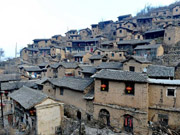 800-year-old ancient village in Shanxi
800-year-old ancient village in Shanxi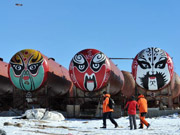 A glimpse of China's Zhongshan station in Antarctica
A glimpse of China's Zhongshan station in Antarctica Female marines receive tactical training in NW China
Female marines receive tactical training in NW China Shanghai women fall in love with Aerial Yoga
Shanghai women fall in love with Aerial Yoga This is Beijing – Nanluoguxiang
This is Beijing – Nanluoguxiang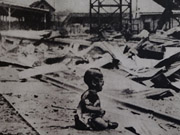 Old photos of Anti-Japanese War (1937-1945)
Old photos of Anti-Japanese War (1937-1945)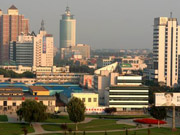 Top 10 cities for falling house prices in January
Top 10 cities for falling house prices in January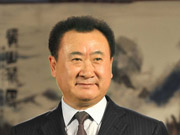 Top 10 richest real estate tycoons: Hurun
Top 10 richest real estate tycoons: Hurun Large numbers of ancient coins excavated in Inner Mongolia
Large numbers of ancient coins excavated in Inner Mongolia British WWII veteran: I can't forgive Japan
British WWII veteran: I can't forgive Japan Top 10 brands that win rich women's hearts
Top 10 brands that win rich women's hearts Memorizing the Flying Tigers
Memorizing the Flying Tigers The Chinese Dream: the Chinese Spirit and the Chinese Way
The Chinese Dream: the Chinese Spirit and the Chinese Way
Day|Week|Month